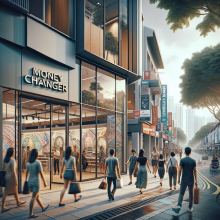How Does Income Inequality Affect Society? (Key Impacts)
Income inequality refers to the extent to which income is distributed unevenly among a population. It is a critical issue that affects societies globally, influencing various aspects of life, from economic growth to social stability. The gap between the rich and the poor has been widening, creating a range of challenges that need to be addressed. Understanding the root causes and consequences of income inequality is essential for creating effective policies to combat it.
In many societies, income inequality is driven by factors such as education disparities, technological advancements, and globalization. These elements can amplify the wealth of those who are already well-off while leaving behind those who are less fortunate. As a result, the rich continue to get richer, and the poor struggle to make ends meet.
The impacts of income inequality are far-reaching. They can hinder social mobility, limit access to quality health care, and even affect crime rates. It is essential to explore these impacts in depth to grasp the full scope of how income inequality affects society.
Are you interested in understanding more about the profound effects of income inequality on our world? Click Here for More Info!
Social Mobility and Inequality

Social mobility refers to the ability of individuals or families to move up or down the social and economic ladder over time. Income inequality has a direct and profound impact on social mobility. In societies with high levels of income inequality, the gap between different socioeconomic classes can become so vast that it creates barriers to upward mobility.
One of the primary ways income inequality affects social mobility is through education. Access to quality education is often skewed in favor of those from wealthier backgrounds. Families with higher incomes can afford better schools, private tutoring, and extracurricular activities that enhance their children’s educational outcomes. Conversely, children from low-income families may attend underfunded schools, which can limit their academic achievements and future career prospects.
Additionally, income inequality can influence social mobility through the job market. High-income individuals often have access to networks and opportunities that can lead to lucrative job positions. On the other hand, those from lower-income backgrounds may find it challenging to access such opportunities, even if they possess the necessary skills and qualifications. This disparity can perpetuate a cycle of poverty, making it difficult for individuals to improve their economic status.
Moreover, income inequality can affect social mobility by limiting access to essential services such as healthcare and housing. Poor health and unstable living conditions can hinder an individual’s ability to work and advance in their career, further entrenching them in poverty.
Understanding the relationship between social mobility and income inequality is crucial for developing policies that promote a more equitable society. By addressing the root causes of income inequality, we can create a more level playing field where everyone has the opportunity to succeed.
Economic Growth and Income Disparity

Income inequality doesn’t only impact individuals; it also has significant implications for the broader economy. The relationship between economic growth and income disparity is complex and multifaceted, influencing various aspects of a nation’s economic health.
One key issue is that high levels of income inequality can stifle economic growth. When wealth is concentrated in the hands of a few, lower-income individuals have less disposable income to spend. This reduced consumer spending can lead to lower demand for goods and services, ultimately slowing down economic growth. Economies thrive on a vibrant middle class with the purchasing power to drive demand, innovation, and job creation.
Income inequality also impacts investments in human capital. In more equal societies, there is generally greater investment in education, healthcare, and other public services. These investments are essential for developing a skilled and healthy workforce, which is a critical driver of economic growth. However, in highly unequal societies, public investments may be insufficient or unequally distributed, limiting the potential for human capital development.
Moreover, income disparity can result in political and social instability, which can have adverse effects on economic growth. High levels of inequality can lead to social unrest, as marginalized groups may feel disenfranchised and demand changes. Political instability can create an uncertain business environment, deterring both domestic and foreign investments, and thus hampering economic growth.
Furthermore, income inequality can lead to a misallocation of resources. Wealthy individuals may invest in financial assets rather than productive activities that generate jobs and stimulate the economy. This behavior can exacerbate economic disparities and create a cycle where the rich become richer while the poor struggle to improve their circumstances.
Addressing income inequality is not just a moral imperative but also an economic one. Policymakers need to consider strategies that promote fairer income distribution to ensure sustainable and inclusive economic growth. Such strategies could include progressive taxation, increased access to quality education and healthcare, and policies that support small businesses and job creation.
Public Health and Socioeconomic Status

The link between public health and socioeconomic status is undeniable. *Income inequality* often translates into significant disparities in health outcomes, affecting everything from life expectancy to the prevalence of chronic diseases.
One of the most striking impacts of socioeconomic status on public health is access to healthcare. Individuals in lower income brackets often face barriers to accessing quality healthcare services. These barriers can include lack of insurance, high out-of-pocket costs, and geographical disparities in healthcare facilities. As a result, lower-income individuals may delay or forgo necessary medical treatments, leading to worsened health outcomes.
Moreover, income inequality is associated with differences in lifestyle and environmental conditions. Lower-income communities are more likely to experience poor living conditions, such as overcrowded housing, exposure to pollutants, and limited access to nutritious food. These factors contribute to higher rates of respiratory diseases, cardiovascular conditions, and other health issues.
Chronic stress stemming from financial instability and social inequities also plays a crucial role in public health. The constant pressure of making ends meet can lead to psychological distress, which in turn can manifest as physical health problems. Stress-related conditions such as hypertension, depression, and anxiety are more prevalent in economically disadvantaged populations.
Educational disparities further exacerbate public health issues linked to socioeconomic status. Education often correlates with health literacy, which affects individuals’ ability to make informed health decisions. Lower educational attainment can lead to a lack of understanding about preventive care, healthy lifestyle choices, and the importance of regular medical check-ups.
Additionally, income inequality can affect public health on a community level. Communities with high income disparity often have underfunded public health systems, fewer recreational facilities, and limited access to community health programs. These deficiencies can hinder efforts to promote overall community well-being and reduce health disparities.
Addressing the health impacts of income inequality requires a multi-faceted approach. Policies aimed at reducing economic disparities, improving access to healthcare, and investing in community health resources are crucial. Enhancing health education and promoting preventive care can also help bridge the gap between socioeconomic status and public health outcomes.
Crime Rates and Social Strain
The correlation between *income inequality* and crime rates is a topic of extensive research and debate. Economic disparities contribute significantly to social strain, which in turn can lead to higher crime rates. Understanding the dynamics of this relationship is crucial for policymakers and society at large.
One way income inequality influences crime is through the concept of relative deprivation. When individuals perceive themselves as being significantly worse off compared to others, feelings of resentment, frustration, and injustice can arise. This sense of deprivation can motivate some individuals to engage in criminal activities as a means of attaining what they perceive to be an equitable share of resources.
Social strain theory further explains the link between economic inequality and crime. According to this theory, societal structures may pressure individuals to achieve socially accepted goals, such as wealth and success. However, when legitimate means to achieve these goals are limited or inaccessible—often the case in economically disadvantaged communities—individuals may resort to criminal behavior as an alternative path.
Moreover, high levels of income inequality can erode social cohesion and trust within communities. When people feel disconnected and distrustful of their neighbors and local institutions, it weakens the social fabric that typically acts as a deterrent to crime. In such environments, the absence of strong, supportive community networks can lead to an increase in criminal activities.
Economic disparities are also linked to varying levels of law enforcement and judicial resources. Wealthier areas often have better-funded police forces, more comprehensive surveillance systems, and quicker judicial processes. In contrast, economically deprived areas may suffer from under-policing, slow judicial response, and a lack of resources for crime prevention programs. This imbalance can result in higher crime rates in poorer communities, perpetuating a cycle of poverty and criminality.
Additionally, the economic strain on families in low-income neighborhoods can lead to domestic issues, including child neglect and abuse, which can have long-term psychological impacts. These adverse childhood experiences can increase the likelihood of future criminal behavior, thereby perpetuating the cycle of crime and poverty.
Addressing the relationship between income inequality and crime requires comprehensive strategies that go beyond traditional law enforcement. Policies aimed at reducing income disparity, improving educational and employment opportunities, and strengthening community bonds are essential. By tackling the root causes of social strain, society can work towards lowering crime rates and fostering a safer, more equitable environment for all.
Policy Solutions to Income Inequality

Tackling the pervasive issue of *income inequality* requires a multifaceted approach that combines various policy solutions. Governments, institutions, and communities must work collaboratively to implement strategies that promote economic equity and social justice.
One of the most effective measures is progressive taxation. By ensuring that higher-income individuals and corporations pay a greater share of their earnings in taxes, governments can redistribute wealth more equitably. Progressive tax systems can fund essential public services such as education, healthcare, and social security, which are crucial for leveling the playing field.
**Education reform** is another vital component in the fight against income inequality. Equal access to quality education can provide individuals from disadvantaged backgrounds with the skills and opportunities needed to succeed. Policies that focus on early childhood education, reducing school drop-out rates, and increasing access to higher education and vocational training can have a long-lasting impact on reducing income disparity.
**Minimum wage laws and labor protections** are also essential. By setting a living wage standard and ensuring fair labor practices, governments can help lift workers out of poverty. Strong labor unions and collective bargaining rights can further empower workers to negotiate better wages and working conditions.
**Affordable housing initiatives** play a crucial role in addressing economic inequality. High housing costs can consume a significant portion of low-income families’ budgets, leaving them with little to no disposable income. Policies that promote affordable housing development, provide rental assistance, and prevent housing discrimination can alleviate this burden and help create more stable communities.
**Social safety nets**, including unemployment benefits, food assistance programs, and healthcare subsidies, are critical in providing support to those in need. Such programs can prevent individuals from falling into deep poverty during times of economic hardship and offer a pathway to financial stability.
Lastly, fostering **inclusive economic growth** is essential. Policies that stimulate job creation, support small businesses, and encourage innovation can drive economic development that benefits all members of society. Efforts to close the gender pay gap and promote diversity in the workforce also contribute to a more equitable economy.
Implementing these policy solutions requires political will and public support. It is essential for citizens to advocate for change and hold their leaders accountable. By working together, society can move towards a future where economic opportunities are accessible to everyone, regardless of their background.
To learn more about how you can support and advocate for these policy changes, Click Here for More Info!














